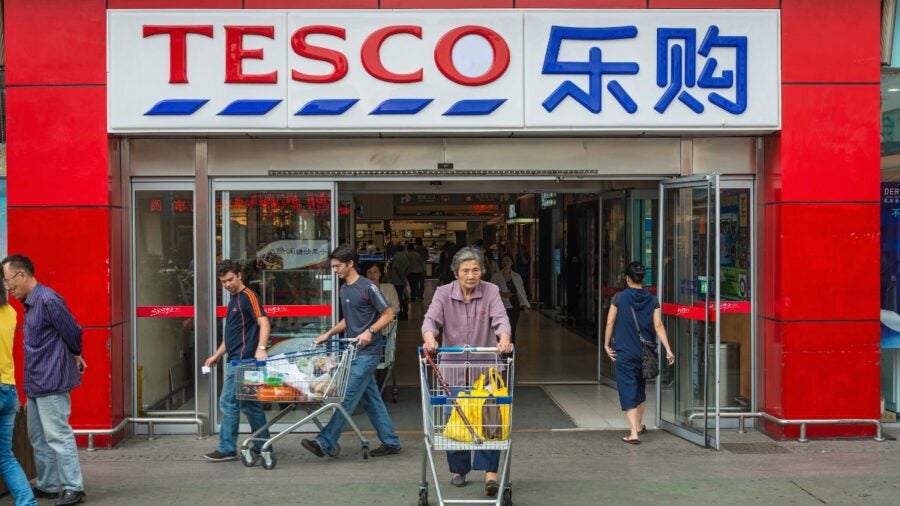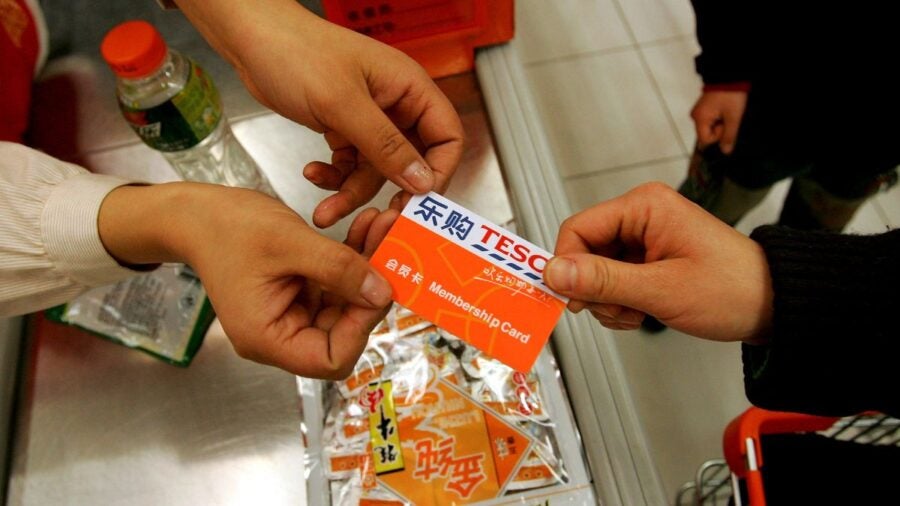
In 2004, Tesco entered the Chinese market after acquiring a 50% stake in Hymall, a chain of grocery stores owned by the Taiwanese corporate group Ting Hsin.
“China is one of the largest economies in the world with tremendous forecast growth and a market we have researched extensively,” claimed Sir Terry Leahy, the British retailer’s chief executive at the time, adding that “these are a billion customers we cannot afford to ignore.”
Tesco and Hymall rebranded together as Tesco Lègòu, combining the English name with its translation in simplified Chinese. They used the British company’s red-and-blue colour scheme while stylising as Tesco 乐购. Tesco soon increased its stake to 90%, as it took control of the project, opening more stores around China and stocking many of its own labelled products.
But, in 2013, after nine consecutive loss-making years, Tesco announced it was merging its 131 outlets in the country with the state-funded retailer, China Resources Enterprise, in exchange for a 20% stake. By 2020, Tesco had sold that remaining stake and withdrawn its presence from China entirely. So, what went wrong?
Differences between Chinese and Western consumers
According to Qing Wang, professor of marketing and innovation at Warwick Business School, when compared with Westerners, Chinese consumers are “variety seekers”. They tend to prefer to shop around, bargain-hunt, and to buy specific things from specialist traders, rather than trusting a supermarket to have everything they want or need in one place.
Ahead of its move into China, Tesco had actually circulated strategy documents internally, referring to its Clubcard scheme as a “secret weapon”. The company believed that by operating a membership scheme, as it did in the UK, and allowing customers to accumulate points and access discounts, it could replicate similar brand loyalty in China.
What Tesco did not account for, Wang explains, was that many Chinese consumers feel that loyalty does not have to be limited to a single company. “[Off the back of a Warwick Business School study], we found that almost all consumers [in China] participated in at least one loyalty programme,” she says, “and 63% of those who participated in loyalty programmes had loyalty cards from four or more retailers.”
Chinese consumers, Wang adds, believe larger choices give them more “power of control, more motivation to make decisions, more chances to have programmes which suit their needs and a more satisfying shopping experience.”
Chinese geography and politics
China’s dense population centres did not lend themselves naturally to supermarkets based on the outskirts of cities. In Chinese hubs, such as Beijing or Shanghai, there is a predominance of single-person households and high-rise apartments with limited storage, so people are more likely to prefer regular top-up shopping rather than buying in bulk.
Moreover, a large proportion of Chinese consumers tend to walk to the shops, meaning that they will only buy what they can carry. “Tesco’s Clubcard approach fundamentally assumed that consumers would travel to large grocery stores for the sake of saving money and accumulating points,” says Hristina Stefanova, a marketing consultant, with experience helping European advertisers to develop their presence in China. “But the inconvenience and cost of navigating heavy traffic essentially negate any savings achieved through a loyalty card.”

The sheer physical size of China also caused Tesco supply chain issues and impacted its capacity to distribute. Perishable food products, in particular, were at risk when being transported over large distances.
Politics played a part in Tesco’s failure in China, too. Government campaigns, such as the “Made in China” drive to encourage consumers to use local businesses at the expense of foreign firms, made marketing more difficult. “Tesco faced strong competition from well-known local brands with established relationships with suppliers,” notes Claire Trachet, chief executive of business advisory Trachet. The decision to buy out its initial local partner, then, could be viewed as having been too hasty.
Entering the market too late
There is an argument to suggest that Tesco entered the Chinese market too late to begin with. Trachet points out that rivals like Walmart or Carrefour, which opened branches in China several years prior, were able to access a number of advantages. “Tesco’s late entry limited its ability to secure prime store locations at lower costs and gain a significant share of the Chinese grocery market,” she says.
“The rapid adoption of online shopping in China further intensified the challenge,” Trachet adds. Indeed, as the internet became more widely available to China’s expanding middle-class, ecommerce sites such as Jingdong, Alibaba and Tencent began to offer an attractive and convenient option, unhindered by the cost of foreign mark-ups.
What can other companies learn from Tesco’s mistakes in China?
“Understanding Chinese consumers is going to be a long and sometimes painful process,” reflects Wang. “But if firms like Tesco are ever going to avoid being stuck in between the more established Western retailers and the Chinese retailers who have the intimate knowledge of the local consumers, this understanding is crucial.”
Tesco’s failure in China, then, should teach other businesses two key lessons. The first is that they should be open to joint ventures, particularly in a new, foreign market where consumers are unfamiliar with their brand or products.
The second is to invest heavily in local knowledge and to tailor their approach. Exporting staff or strategies from one country to the next is a risky tactic. Tesco relied on expat management in many of its stores and attempts to localise its product range, for example by stocking live turtles or toads, came too late.
China is a difficult market to crack and Tesco is not the only Western retailer to discover this. But, with planning, research, and local insights, it is not impossible.

In 2004, Tesco entered the Chinese market after acquiring a 50% stake in Hymall, a chain of grocery stores owned by the Taiwanese corporate group Ting Hsin.
“China is one of the largest economies in the world with tremendous forecast growth and a market we have researched extensively,” claimed Sir Terry Leahy, the British retailer’s chief executive at the time, adding that “these are a billion customers we cannot afford to ignore.”
Tesco and Hymall rebranded together as Tesco Lègòu, combining the English name with its translation in simplified Chinese. They used the British company’s red-and-blue colour scheme while stylising as Tesco 乐购. Tesco soon increased its stake to 90%, as it took control of the project, opening more stores around China and stocking many of its own labelled products.
